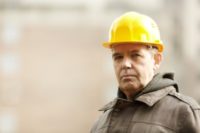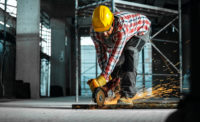Protecting your aging workforce should be a priority

Along with age, comes expertise. Oftentimes, the greatest and most trusted resources on a job-site are the individuals who have been with the company, or in the field, for the longest period of time. Older workers are reliable and provide invaluable insight, experience, and their pride in their work is an inestimable asset to their team and employer.
Americans are living and working for a longer time, resulting in tremendous changes within the workplace. People are working longer for many reasons, including the need or desire to continue generating income, the inability to afford early retirement, and the simple fact that some people absolutely love their work. Regardless of their motivation, these employees have decades of experience, and it shows in the wear and tear on their bodies and joints. Over time, all of us will experience a natural loss in strength, flexibility, and endurance.
According the U.S. Bureau of Labor and Statistics, participation rates of seniors, 55 and up have continued to increase since 1996. Comparing these statistics to earlier generations is shocking. Individuals 55-64, are projected to comprise 66.6% of the workforce by 2026, compared to 57.9% in 1996. People aged 65-74 have a projected participation rate of 30.2%, which was 17.5% in 1996.1
Protecting the aging workforce is a growing issue in every workplace.
Within the construction industry specifically, keeping older workers safe should be of utmost importance and this industry is facing the same workplace trends as others, showing continued growth. Labor Force Statistics from the U.S. Bureau of Labor Statistics, shows that workers aged 45-65+ makes up almost 45% of the construction workforce.2
Employers have a moral obligation to protect one of their greatest assets; their aging workforce who have shown up every day and put their entire body into getting the job done. Companies need to gear up, figuratively and literally, for the baby boomer generation which is likely to exacerbate current ergonomic and safety issues in the workplace. Not all businesses are geared up to handle these aches and pains in their industry and can experience financial and physical loss and depreciation.
Risk assessment
Looking back at 2017 and 2018, the U.S Bureau of Labor and Statistics shows us as that there were 2.8 million workplace injuries and illnesses. Of these endangered employees 240,160 endured injury due to slips, trips, and falls. In 2018, there were 791 fatalities from slips, trips and falls. This shocking statistic was actually a slight decrease from the prior year. Still, no one should lose their life on a job-site.3
In the construction industry, creating the safest workplace for workers seems like an overwhelming and unachievable task. Construction sites are innately dangerous. However, ensuring each job-site follows OSHA standards and goes through personalized risk assessments is critical to workplace safety.
Conducting a thorough risk assessment provides employers with valuable insight into the health and safety risks facing workers, inspectors, and anyone else who visits the construction site.
The person performing the risk assessment should do the following:
- Clearly identify all workplace hazards: are employees facing mental, physical, biological or chemical hazards? If you are not sure about something make sure you make it a team discussion. Getting everyone involved in safety precautions increases employee engagement.
- Take note of any potential injuries (including their severity): who is working on the job-site? Are they part-time or full-time? Are worker’s schedules managed in a way to prevent fatigue? If anyone is working in the evening, are they provided adequate lighting? Knowing who and what can prevent a lot of future questions and concerns.
- Designate potential solutions to each hazard that can reduce the risk of injury or illness: at this point in your assessment you know who is working at the site and what dangers they will potentially face. Again, eliminating all risks is an impossible task. However, you can break down your findings into measures that can be implemented and attained.
These three steps can make a big difference on each and every job-site, saving time, energy, injury and illness in the future. It’s important to document all of your findings, create safety signage and materials when applicable, and discuss safety standards with your team.
Protection that pays off
Construction workers face a myriad of health and safety hazards each day while they work. They are exposed to falling/loose objects, are required to lift heavy items, and utilize dangerous equipment and heavy machinery. These are difficult tasks for a young adult. As we age, our bodies slow down. Our balance and flexibility is impaired, along with our reflexes and response time. Employers need to protect their workers, especially their aging workforce, from harm.
To prevent injuries and illness, workers should take multiple breaks throughout the day and should feel free to rehydrate as much as they need to stay alert and work safely. Keeping employees on their feet, pain free, can seem like a daunting task. However, providing workers the right PPE can alleviate worker’s current aches and pains, while simultaneously preventing major health and wellness issues down the road.
Construction workers are constantly walking on hard and uneven surfaces, filled with dangerous items such as shards of glass and nails. Their feet ache and take a literal beating from their work boots and their workplace environment. Puncture resistant anti-fatigue insoles not only support and comfort workers, but they also provide much needed protection from objects that can penetrate and potentially stab workers.
Construction workers don’t have the luxury of sitting in a comfortable office space, walking around on smooth and even flooring. Instead, employers need to help these workers stay energized and on their feet. Personal anti-fatigue insoles reduce aches and pain throughout the body. They also reduce slips, trips, and falls by increasing balance. Personal anti-fatigue insoles made of dual layer memory foam, provide constant and continuous support and shock absorption.
The aging workforce also benefits from offering an anti-fatigue diabetic insole. This unique offering allows older employees, coping with diabetes to feel fully supported in many ways. Dealing with an illness like diabetes can be an isolating and lonely experience. Companies offering their workers PPE that acknowledges their personal health battle helps those workers feel seen and understood. It’s important to provide aging employees with PPE that truly serves and protects them. Diabetic personal anti-fatigue mat insoles provides maximum shock absorption, comfort and unique pressure distribution that relieves pressure from sensitive areas, often made worse by diabetes.
Constructing goals that make a difference
Many employers don’t realize that unorganized, unsafe job sites are extremely expensive. A construction site that has been assessed with honesty and purpose can save a company time, money, while preventing employees unnecessary injury.
Protecting our aging workforce goes beyond protecting a business' bottom line. We can no longer afford to have more and more of our population move into and through their golden years disabled from physical jobs. When it comes to safety concerns, the best way to prevent most of them from happening would be to employ a proactive approach. Investing in the health and safety of your aging workforce ensures a stronger and more successful workplace and business.
References
Looking for a reprint of this article?
From high-res PDFs to custom plaques, order your copy today!








